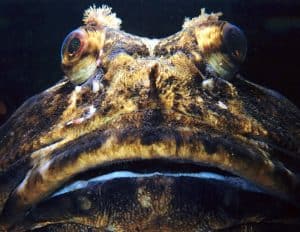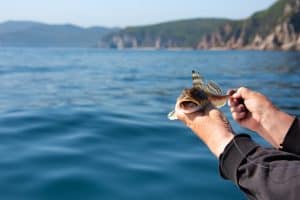Sculpin is a fish, but does it taste good? Most people have never even heard of it. That’s because this fish is fairly uncommon and is only found in certain parts of the world.
Sculpin is a type of rockfish, which means that it lives among rocks on the ocean floor and can be found at relatively low depths in most oceans. It can also be differentiated from other fish by its color patterns, which are characterized by dark lines against a light-colored background.
If you’re interested in trying sculpin, here are some fun facts about this curious fish – What exactly makes sculpin taste so good?

What is sculpin?
Sculpin is a type of fish found in the Pacific off the coast of California. The fish is fairly uncommon, and is only found in certain areas. It can be distinguished from other fish by its color patterns, which are characterized by dark lines against a light-colored background.
Some people don’t know that sculpin can be used to make sauces as well as a topping on seafood or salads. The sauce tastes great with lighter meats like chicken or pork, too!
Sculpin Facts
Sculpin is a small, deep-water fish and has a mild taste. It’s mostly white, with dark spots on its head and back, as well as light lines running down the side of its body. It has a frilly mouth that looks like a scallop shell and has two different colors on the head (black and yellow). They are usually found in the East Coast, but can be found in other areas as well.
The average adult sculpin will be around 4 inches, but it can grow up to 8 inches long. Sculpin is often eaten whole, but it is also often eaten as fillets or steaks. It has high levels of Omega-3 fatty acids and Vitamin D primarily because it eats small crustaceans and worms. Different types of cooking methods include pan frying, deep frying, grilling and baking.
Some other facts include:
It lives at the bottom of the ocean floor and is most often found near rocky areas.
It eats different types of other sculpins, including their eggs and larvae, crabs, shrimps, clams and other crustaceans.
It’s a carnivore! This means that it eats meat as opposed to plants.
When threatened or attacked by predators like seals or fish from below, sculpin will quickly swim upwards towards the surface so that they don’t get eaten.
Can you eat sculpin?
Yes, you can eat sculpin and it tastes good. It’s not uncommon to find sculpin on the seafood menu in some places, but it’s not sold in most fish markets.
The meat of sculpin is a dark-red color and has a slight taste of the rock it lives on. The meat isn’t really meant to be eaten on its own, though. Sculpin is most commonly served as sushi or sashimi and is usually combined with other types of fish like salmon, yellowtail, and sea bass.
It might take some practice to learn how to properly prepare this type of fish for eating because it’s not usually sold at supermarkets and restaurants. But when you do get your hands on some sculpin, you’ll be glad you did!

How does sculpin taste like?
Many people would agree that sculpin tastes like the ocean. Sculpin’s meat is very firm, and it has a texture similar to a clam. The flavor of this fish is also enhanced by the amount of salt in its flesh. In fact, sculpin was originally salted to preserve it for export and transport to other countries.
Another interesting consideration about sculpin is whether or not you can eat it raw. This fish is actually quite delicate and does not taste as good when eaten raw as when cooked. So, if you’re going to eat this fish, make sure you cook it first!
Sculpin and health benefits
There has been some evidence suggesting that sculpin may have a high nutritional value and may be good for your health, particularly because it’s low in calories. Depending on the size of the fish, there may be 1,000 to 3,000 milligrams of protein in a single serving (a fat sculpin can hold significantly more). Sculpin also contains Omega-3 and -6 fatty acids, which are beneficial for heart health. The fish is also important for helping with mental development and promoting healthy brain function.
Sculpin is also rich in calcium, as well as other minerals such as magnesium and phosphorus. The fish also provides vitamins A, B1 and B2. Consuming sculpin will provide your body with a source of iodine. Finally, the protein content in the fish provides an excellent source of protein while still being low in fat.
Is eating sculpin good for you?
This fish is a type of rockfish, but that doesn’t mean that it’s not good for you. It contains high levels of protein and omega-3 fatty acids which can be found in many other types of fish as well. Not only that, but sculpin is a great source of calcium and low in calories compared to other types of seafood.
A lot of people eat sculpin because it tastes so good. If you’re interested in trying this fish, you won’t regret it!
What are the different ways to cook sculpin?
Sculpin can be cooked in a variety of ways. Because it can be found at relatively low depths and is fairly uncommon, it’s possible to use sculpin to make tasty dishes. Some common methods of cooking are grilling, poaching, and steaming. It can also be used in soups and stews.
How do you eat this fish? Most people cut the meat off the filet and eat it with their hands. However, some people may choose to simply cook the fish whole and then serve themselves. Those who want to spice up their meal could also garnish their dish with lemon wedges or a sprig of parsley.

Conclusion
Sculpin is a type of fish that has a unique taste and health benefits. This fish is often eaten whole, especially in the United States. Sculpin is not only an excellent source of protein, but is also rich in vitamins and minerals. Sculpin is an excellent option for people who want to eat fish with a low fat content.
Make sure to check out our articles on alternative fish and seafood to consider eating, e.g.: blue marlin, cobia, flounder, horseshoe crab, ladyfish, pike, perch or tarpon.